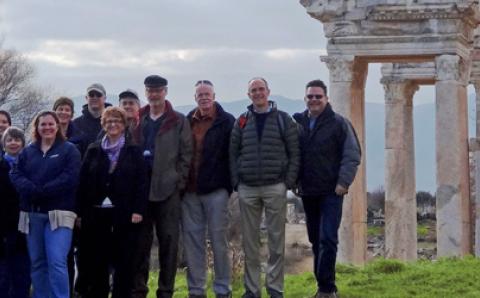In October 2012 the Pew Research Group revealed the results of a study of religious affiliation: young people are more likely now than ever before to identify their religious beliefs as “nothing in particular.” “The rise of the nones,” as this trend was quickly dubbed, garnered media attention in national outlets from Time magazine and The Huffington Post tothe Los Angeles Times and The Washington Post.
More important, it seized upon latent uneasiness in the Christian community. The Internet lit up with articles written by pastors and prominent bloggers, by anyone who’s ever left a church—and even by that guy who once went to church with a friend and who now has opinions about it. Everyone wanted a chance to define and redefine the problem so that they could take a stab at outlining the solution: “10 Ways the Church Has It Wrong”; “5 Ways to Keep Your Kids from Leaving Church”; “8 Ways to Win Them Back”; “How to Succeed in Church by Really, Really Trying.”
Articles like these get passed around as e-mail forwards and as Facebook links. Focus on the Family has an opinion. Sojourners has an opinion. Everybody has their say. The rise of the “nones” has become our chance to spread the news, just like Chicken Little: “The church is falling! The church is falling!”
Fearful Faith
As these concerns permeate North American Christianity as well as our denomination and our congregations, we feel the destructive forces of fear and anxiety preying on us.
The older members of our congregations are lamenting their real pain. Their daily prayers rehearse the disappointment of the seemingly unrealized baptismal vows they made on behalf of their own sons and daughters. The middle generation looks toward churches that are growing numerically; they wonder if subwoofers and fog machines might do the trick in their sanctuary too. Their proactivity flows out of a deep-seated anxiety that they haven’t done enough and that their kids may be the next ones to step outside the church doors.
Young adults who have left the church report how their lives no longer fit into the perfect pews. Friends who practice other religions make the exclusive claims of Christ uncomfortable, to say the least. Later ages for starting a family and the new reality that marriage is no longer a given make the chastity pledges of their teenage years seem quaint, not nearly adequate to real life. They share stories of hypocrisy and abuse—and stories of a genuine, simple childhood faith that now seems obsolete to the grad student who is asking big questions that are no longer satisfied by the answers provided by formerly cherished Sunday school teachers.
The fears of parents and grandparents are real, as are the anxious struggles of 20- and 30-somethings. In fact, all of this heightened inquiry about the “nones” is a symptom of our fearful faith. Before treating those who have left the church as a sociological category, before making generalizations, the church would be wise to recognize and treat this “dis-ease” for what it really is: the painful expression of disappointed hearts. The stories we hear are as unique as the individuals who tell them. Make no mistake, faith—for those who have it and for those who are alarmed to discover they don’t, or who might not have the “right” kind—is the fearful reality of discipleship. It always has been.
Fearful Faith: The Prequel
On Thursday night the disciples entered the garden of Gethsemene with Jesus to pray. Although they tried to keep Jesus company, they couldn’t help nodding off. In that moment, though, as eyelids drooped, chins landed gently on chests, and snores sounded through the olive grove, all was right with the world—at least from the disciples’ perspective.
Until suddenly they awoke to the metallic clang of armor, the bobbing flames of torches winding their way through the garden, the voices of uninvited guests. Then Judas, one of their own, emerged from the sinister gang. And Jesus, who seemed to expect it all, was betrayed, arrested, and led away. Dread rushed into the soul space created by Jesus’ absence.
Peter heard the twisted testimony before the Sanhedrin and shook with the injustice of it. Abandoned at the fire pit, Peter stood and denied knowing his friend—and then wept for the shame of his denial. Returning to a handful of the others, the disciples hid away in their locked upper room. In confusion they pored over the events of the last 24 hours, perhaps even the past three years, searching for clues. Could this have been part of the plan all along? It certainly wasn’t the salvation they had expected. Throughout the night they played out different scenarios, alternating between revolt and further retreat.
On Friday, awash with dread and disappointment, fearful that their years of faithfulness had been a miscalculation, the disciples saw Jesus, beaten and bearing the strain of the wooden beam, marching toward the hill of criminal execution. They followed him to the cross in stunned silence. And at the end of the day, after Jesus had died, they slunk back to their rented room.
That night, the previous evening’s strategy session was replaced by silent grief. All the disciples’ hopes of a new kingdom, their visions of salvation, their dreams of God finally making good on his Messianic promises and choosing them to lead the charge—all these dreams were as dead as Jesus, buried with him in a hastily borrowed tomb.
The disciples’ faith—weak and waning further—was the fearful reality of their discipleship.
Jesus Is Risen!
Sunday came, and with it the women’s task of preparing the body. Creeping away from the other disciples, they came to do their part—honoring Jesus in the ordinary way they knew. They brought their spices for anointing and mentally prepared themselves for the scene that awaited, steeling their hearts against the great pain of death. Surely this was not their first trip to a tomb. Not their first experience of honoring their beloved dead.
But as the women approached the tomb, they heard the angel’s pronouncement: “Do not be afraid, for I know that you are looking for Jesus, who was crucified. He is not here; he has risen, just as he said. Come and see the place where he lay. Then go quickly and tell his disciples: ‘He has risen from the dead and is going ahead of you into Galilee. There you will see him’” (Matt. 28:5-7).
So the women ran from the tomb. The text says they hurried away from the tomb, “afraid yet filled with joy.” At the empty tomb, the women did not shed their fear entirely. Instead, God replaced one fear—that the rest of their lives would only ever be the despair of crucifixion and disappointed hopes—with another. This new fear was of a different sort, a crazy hope that there might yet be something new ahead. Something beyond their imagination, something worth living for. The crazy hope that death is not forever. The hope that disappointment and anxiety and fears might yet be overcome by peace, purpose, and the hope of new life. Resurrection hope propelled them forward. The joyful dawning of life caused them to run, and in chasing their wild, jubilant hope, they found Jesus. They discovered Jesus along the way.
The Joyful Gamble of Faith
It is easy to define resurrection by stories of obvious growth—in numbers, in younger members, in new programs and new churches. It’s understandable that we want to know the results—or at least a reliable estimate that all of our effort is going to be worth it—before we begin. But the first evangelists, the women at the tomb, started out on a gamble: a fearful gamble on a crazy hope. In other words, they had faith, and they discovered Jesus along the way.
In December 2011, Parchment Christian Reformed Church, located just northeast of Kalamazoo, Mich., took a similar step of faith. They were a small congregation and growing smaller. They had every reason to fear. The congregation faithfully made and executed plans to reach their neighborhood and took every opportunity to accommodate new members. But new members didn’t come—and in this regard, their story is not unique.
Most American churches are small. They are filled with faithful disciples, yet their ministry goes uncelebrated. As these churches grow smaller, committed members and loving pastors read everything they can about why the church is failing and how they might change.
We fight to keep things the way they’ve always been because that’s the way we’ve seen God show up before. We fight to change everything because, well, obviously, nothing is working. We fight to avoid the worst-case scenario: our churches may fail. In this we resemble nothing so much as disciples in a locked upper room on Good Friday, shaking our heads clear and trying to figure out how God came to let us down so badly.
Facing down their fear, Parchment CRC discovered a crazy hope that maybe life is born of death. In December 2011, this church of faithful saints voted to close their doors. They grieved, they wept. They were full of fear. Pastor Kevin Heeres walked with them through the valley of the shadow of death, reminding them in his final sermon, “When God does a new thing—when he brings about resurrection—it is never comfortable for us. Grace is not giving us what we want. Grace is about giving us what we need.” Psalm 23 tells us ever so clearly that following God is just as likely to lead to valleys of the shadow of death as it is to quiet waters and abundantly apportioned tables. The trouble with our fear—exacerbated by the fuss surrounding the “nones”—is that it gives us permission to linger in valleys while the Shepherd beckons us toward green pastures.
As they crept out of the upper room to confront the hard work of death, the faithful disciples at Parchment Christian Reformed Church were given life. Rather than gobbling up their financial assets to keep themselves afloat, they began to wonder what the sale of those assets could accomplish for the kingdom. They brainstormed and they dreamed and they looked around them for signs of life. In the end, they donated more than a quarter million dollars to missionaries, to local organizations reaching out to at-risk youth, to the gospel mission, and to local Christian social service organizations. They gave funds to Christian education in their community and internationally. They gave donations to partially fund two different church planting endeavors. And, just for fun, they sent a group of 25 Christian school teachers on a 10-day tour of the Holy Land.
Expecting death, they heard the call of life at the tomb. They heard the angel’s words: Do not be afraid. “God’s way to bring about resurrection was not only to bless other ministries, but also to send us out into both familiar and new places,” said Pastor Heeres. “We became what church was always meant to be. We just didn’t get there on the road we dreamed of.” They were what the church was always meant to be, proclaiming, like the women at the tomb, “Jesus is risen! Jesus is risen!”
Jesus Is Risen!
The trap set for us by “the rise of the nones” and every doomsday prophecy that ever was and ever will be is that we might come to underestimate the power of resurrection. To predict the end of the church—with horror or with glee—gives us tacit permission to set up housekeeping in the locked upper room of our own fear and doubts. To predict the end of the church undercuts the courage it takes to join the women on their way to the tomb. The courage it takes to confront death and be surprised by life.
It’s easy to measure resurrection by the obvious—numerical growth, excitement, or new programs. But resurrection will not be categorized in base measurements. Rather, resurrection shapes us whether we are seated in a crowded sanctuary or locking the church doors behind us for the last time. Resurrection is there in the pews, in the world, and in the life of every believer, because dying and rising are the given pattern of Christian living.
Resurrection calls us, like the women seeking Jesus at the tomb, to “hurry away, afraid yet filled with joy.”Leaving the shelter of our locked upper rooms, God calls us to leave behind our fear of an unknown future. God calls us to the crazy hope of resurrection, otherwise known as faith. God calls us out to go and tell and to find Jesus along the way. Whether it’s the story of Easter morning or the story of a dying church living on or our own discovery of life springing from death, resurrection is our chance to spread the good news: Jesus is risen! Jesus is risen!
Web Questions
- Jenista says that the furor over the rise of the nones “seized upon latent uneasiness in the Christian community.” What are some of the root causes of this uneasiness in the church in general? In your own congregation?
- The idea that the church is failing has been widely discussed in the media, including social media. How do you respond to that suggestion? What are your hopes or fears for the future of the church?
- Faith is the “fearful reality of discipleship,” says Jenista, and always has been. How does the angel’s “Do not be afraid” message to the women seeking Jesus’ body at the tomb apply to us today?
- Change can be scary and difficult, as Jenista points out in the example of the congregation that closed its doors. But it can also bring about new life. What are some examples of that in your own personal experience or in the experience of your community or congregation?
- How does the power of the resurrection continue to shape our faith even as we face the disappointments and fears of our everyday lives?
About the Author
Meg Jenista is pastor at The Washington DC Christian Reformed Church.








